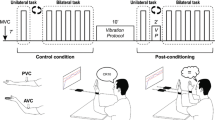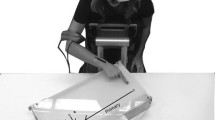Summary
During voluntary movement, muscle spindles of both the agonist and antagonist muscles potentially can supply information about position of the limb. Muscle vibration is known to increase muscle spindle discharge and cause systematic distortions of limb position sense in humans. The following two experiments attempted to examine these contributions by separately vibrating over the triceps and biceps muscles during forearm positioning. In the first experiment, subjects performed a horizontal flexion or extension of the right arm to a mechanical stop randomly positioned at 20, 40 or 60°. Vision was occluded and vibration was applied to the right arm. The perceived position of the right limb was assessed by instructing subjects to simultaneously match the right arm position with the left limb. Vibration of the shortening, agonist muscle had no effect on limb matching accuracy. However, antagonist muscle vibration resulted in a significant overestimation of the vibrated limb position by 6–13°. The procedures for the second experiment were similar to the first, except that movements of the right limb were self-terminated and only flexion movements were performed. A screen was mounted over the arms and subjects were instructed to move the right arm until it was positioned beneath a marker on the screen. Vibration of the shortening agonist muscle had no effect on either the positioning accuracy of the right limb or matching accuracy of the left limb. However, antagonist muscle vibration resulted in significantly shorter movements (6–10°) by the right limb and an overestimation of right limb position by the left, matching limb. These findings support the hypothesis that muscle spindle afferent information from the lengthening antagonist muscle contributes to limb position sense during voluntary movement.
Similar content being viewed by others
References
Al-Senawi DA, Cooke JD (1985) Inter-limb responses to muscle tendon vibration in humans. Soc Neurosci Abstr 11: 74
Amis A, Prochazka A, Short D, Trend P, Ward A (1987) Relative displacements in muscle and tendon during human arm movements. J Physiol (Lond) 389: 37–44
Bullen AR, Brunt D (1986) Effects of tendon vibration on unimanual and bimanual movement accuracy. Exp Neurol 93: 311–319
Burke D, Hagbarth KE, Lofstedt L, Wallin BG (1976a) The responses of human muscle spindle endings to vibration of non-contracting muscles. J Physiol (Lond) 261: 673–693
Burke D, Hagbarth KE, Lofstedt L, Wallin BG (1976b) The response of human muscle spindle endings to vibration during isometric contractions. J Physiol (Lond) 261: 695–711
Burke D, Hagbarth KE, Lofstedt L (1978) Muscle spindle activity in man during shortening and lengthening contractions. J Physiol (Lond) 227: 131–142
Capaday C, Cooke JD (1981) The effects of muscle vibration on the attainment of intended final position during voluntary human arm movements. Exp Brain Res 42: 228–230
Capaday C, Cooke JD (1983) Vibration induced changes in movement-related EMG activity in humans. Exp Brain Res 52: 139–146
Goodwin GM, McCloskey DI, Matthews PBC (1972) The contribution of muscle afferents to kinaesthesia shown by vibration induced illusion of movement and by the effects of paralysing joint afferents. Brain 95: 705–748
Hollingworth HL (1908) The inaccuracy of movement. Arch Psychol 2: 1–87
Hulliger M, Vallbo AB (1979) The responses of muscle spindle afferents during voluntary tracking movements in man: load dependent servo assistance? Brain Res 166: 401–404
Lestienne F (1979) Effects of inertial load and velocity on the braking process of voluntary limb movements. Exp Brain Res 35: 407–418
Marsden CD, Obeso JA, Rothwell JC (1983) The function of the antagonist muscle during fast limb movements in man. J Physiol (Lond) 335: 1–13
Prochazka A, Stephens JA, Wand P (1979) Muscle spindle discharge in normal and obstructed movements. J Physiol (Lond) 287: 57–66
Prochazka A (1986) Proproception during voluntary movement. Can J Physiol Pharmacol 64: 499–504
Roll JP, Vedel JP (1982) Kinaesthetic role of muscle afferents in man, studied by tendon vibration and microneurography. Exp Brain Res 47: 177–190
Roll JP, Vedel JP, Ribot E (1989) Alteration of proprioceptive messages induced by tendon vibration in man: a microneurographic study. Exp Brain Res 76: 213–222
Sittig AC, Denier vander Gon JJ, Gielen CCAM, van Wijk AJM (1985) The attainment of target position during step-tracking movements despite a shift of initial position. Exp Brain Res 60: 407–410
Vallbo AB, Hulliger M, Nord E (1981) Do spindle afferents monitor joint position in man? A study of active position holding. Brain Res 204: 209–213
Vallbo AB (1970) Discharge patterns in human muscle spindle afferents during isometric voluntary contractions. Acta Physiol Scand 80: 552–566
Vedel JP, Roll JP (1983) Muscle spindle contribution to the coding of motor activities in man. In: Massion, J, Paillard J, Schultz W, Wiesendanger M (eds) Neural coding of motor performance. Exp Brain Res Suppl 7: 253-265
Author information
Authors and Affiliations
Rights and permissions
About this article
Cite this article
Inglis, J.T., Frank, J.S. The effect of agonist/antagonist muscle vibration on human position sense. Exp Brain Res 81, 573–580 (1990). https://doi.org/10.1007/BF02423506
Received:
Accepted:
Issue Date:
DOI: https://doi.org/10.1007/BF02423506




